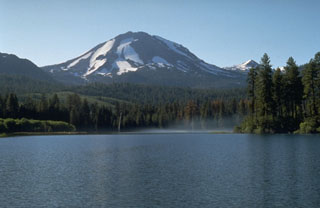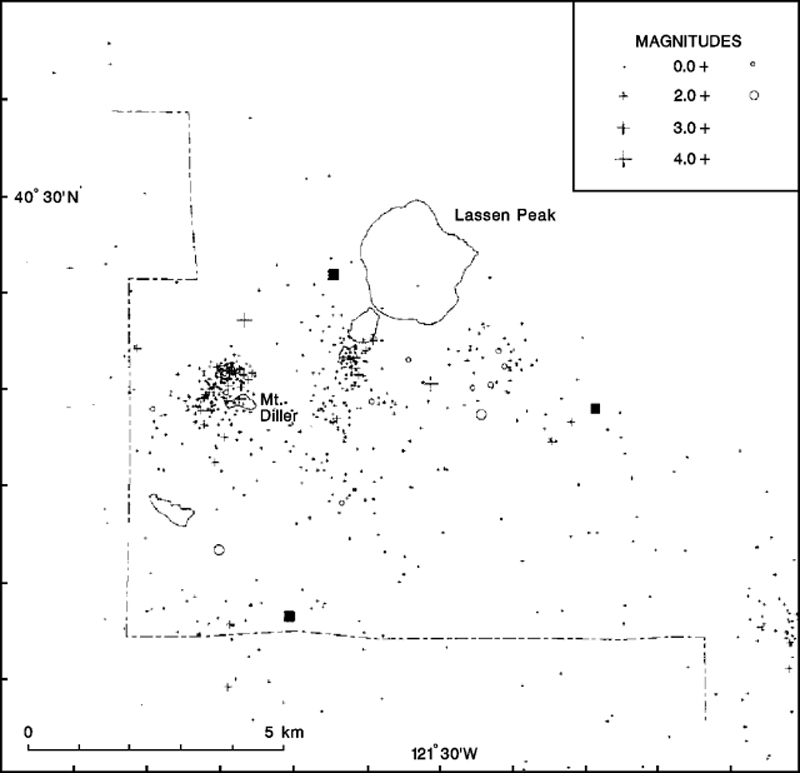Report on Lassen Volcanic Center (United States) — June 1992
Bulletin of the Global Volcanism Network, vol. 17, no. 6 (June 1992)
Managing Editor: Lindsay McClelland.
Lassen Volcanic Center (United States) Seismicity apparently triggered by M 7.5 earthquake hundreds of kilometers away
Please cite this report as:
Global Volcanism Program, 1992. Report on Lassen Volcanic Center (United States) (McClelland, L., ed.). Bulletin of the Global Volcanism Network, 17:6. Smithsonian Institution. https://doi.org/10.5479/si.GVP.BGVN199206-323080
Lassen Volcanic Center
United States
40.492°N, 121.508°W; summit elev. 3187 m
All times are local (unless otherwise noted)
Southern California's largest earthquake since 1952, M 7.5 on 28 June, appeared to trigger seismicity at several volcanic centers in California. It was centered roughly 200 km E of Los Angeles. In the following, David Hill describes post-earthquake activity at Long Valley caldera, and Stephen Walter discusses the USGS's seismic network, and the changes it detected at Lassen, Shasta, Medicine Lake, and the Geysers.
In recent years, the USGS northern California seismic network has relied upon Real-Time Processors (RTPs) to detect, record, and locate earthquakes. However, a film recorder (develocorder) collects data from 18 stations in volcanic areas, primarily to detect long-period earthquakes missed by RTPs. The film recorders proved useful in counting the post-M 7.5 earthquakes, most of which were too small to trigger the RTPs.
The film record was scanned for the 24 hours after the M 7.5 earthquake, noting the average coda duration for each identified event. Some events may have been missed because of seismogram saturation by the M 7.5 earthquake. Marked increases in microseismicity were observed at Lassen Peak, Medicine Lake caldera, and the Geysers (table 1). No earthquakes were observed at Shasta, but the lack of operating stations on the volcano limited the capability to observe small events.
Table 1. Number of earthquakes at northern California volcanic centers during 24-hour periods following major earthquakes on 25 April (40.37°N, 124.32°W; M 7.0) and 28 June (34.18°N, 116.47°W; M 7.5) 1992. Events with coda durations less than or equal to 10 seconds and greater than 10 seconds are tallied separately. Earthquakes were identified from film records of seismograms from nearby stations. Courtesy of Stephen Walter.
| Date | Lassen | Shasta | Medicine Lake | Geysers | ||||
| Codas (seconds) | <= 10 | > 10 | <= 10 | > 10 | <= 10 | > 10 | <= 10 | > 10 |
| 25 Apr 1992 | 0 | 0 | 0 | 1 | 0 | 0 | 7 | 2 |
| 28 Jun 1992 | 8 | 14 | 1 | 5 | 12 | 0 | 46 | 4 |
Film was also scanned for the 24 hours following the M 7.0 earthquake at 40.37°N, 124.32°W (near Cape Mendocino) on 25 April. Although smaller than the 28 June earthquake, its epicenter was only 20-25% as far from the volcanoes. Furthermore, both the 25 April main shock and a M 6.5 aftershock were felt at the volcanic centers, but no felt reports were received from these areas after the 28 June earthquake. Only the Geysers showed any possible triggered events after the 25 April shock. However, background seismicity at the Geysers is higher than at the other centers, and is influenced by fluid injection and withdrawal associated with intensive geothermal development.
Lassen Report. Of the three major Holocene volcanoes in the California Cascades, Lassen (~800 km NNW of the epicenter) had the strongest response to the 28 June earthquake (figure 1). About 10 minutes after the S-wave's arrival and while surface waves were still being recorded, a M 2.8 event occurred south of Lassen Peak. Film records showed 9 more earthquakes in the first hour, and 22 events were identified during the first 24 hours. Although most were M 1 or smaller, at least two and perhaps as many as four were of magnitude greater than or equal to 2. Nine were detected by the RTP system. The best preliminary locations were concentrated ~3 km SW of Lassen Peak at
Geological Summary. The Lassen volcanic center consists of the andesitic Brokeoff stratovolcano SW of Lassen Peak, a dacitic lava dome field, and peripheral small andesitic shield volcanoes and large lava flows, primarily on the Central Plateau NE of Lassen Peak. A series of eruptions from Lassen Peak from 1914 to 1917 marks the most recent eruptive activity in the southern Cascade Range. Activity spanning about 825,000 years began with eruptions of the Rockland caldera complex and was followed beginning about 590,000 years ago by construction of Brokeoff stratovolcano. Beginning about 310,000 years ago activity shifted to the north flank of Brokeoff, where episodic, more silicic eruptions produced the Lassen dome field, a group of 30 dacitic lava domes including Bumpass Mountain, Mount Helen, Ski Heil Peak, and Reading Peak. At least 12 eruptive episodes took place during the past 100,000 years, with Lassen Peak being constructed about 27,000 years ago. The Chaos Crags dome complex was constructed about 1100-1000 years ago north of Lassen Peak. The Cinder Cone complex NE of Lassen Peak was erupted in a single episode several hundred years before present and is considered part of the Lassen volcanic center (Clynne et al., 2000). The 1914-1917 eruptions of Lassen Peak began with phreatic eruptions and included emplacement of a small summit lava dome, subplinian explosions, mudflows, and pyroclastic flows.
Information Contacts: Stephen Walter and David Hill, MS 977, U.S. Geological Survey, 345 Middlefield Road, Menlo Park, California 94025 USA.


